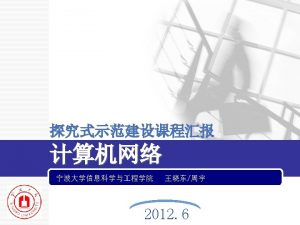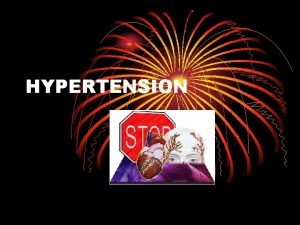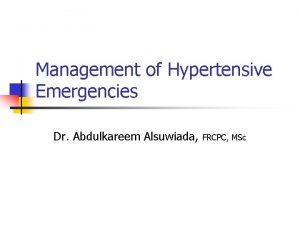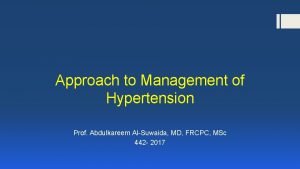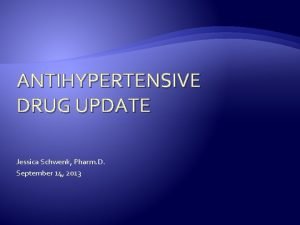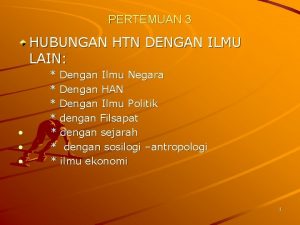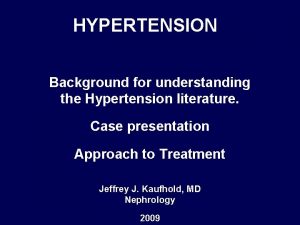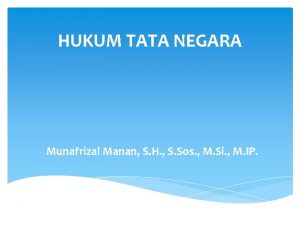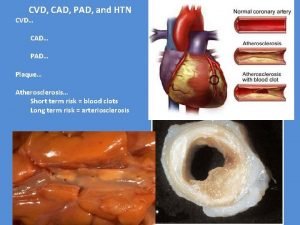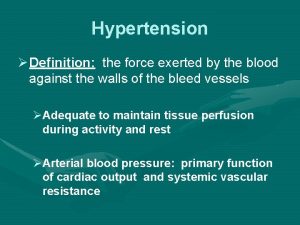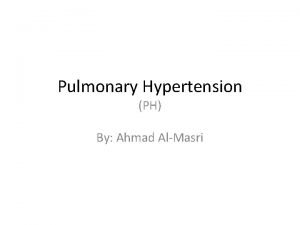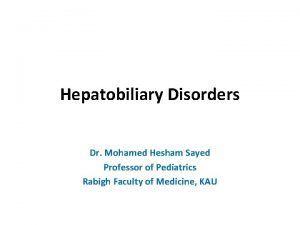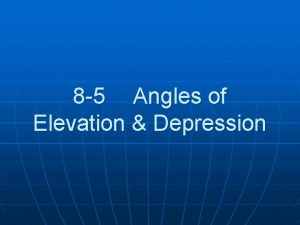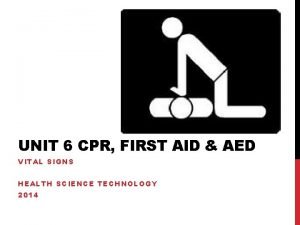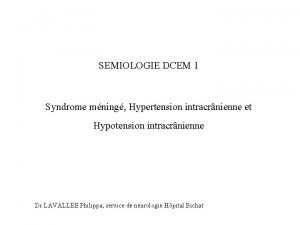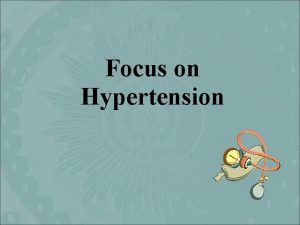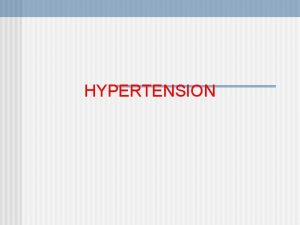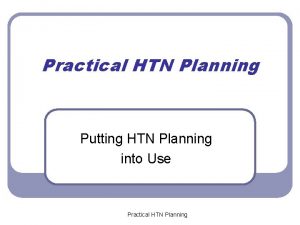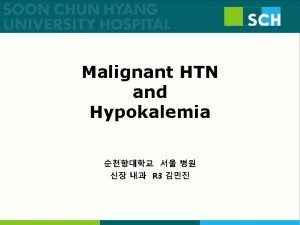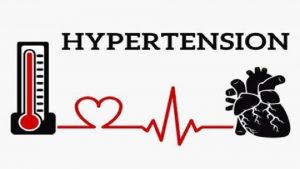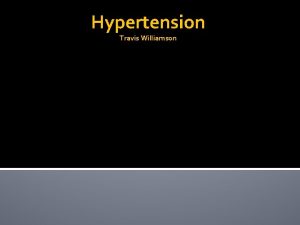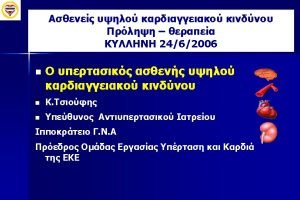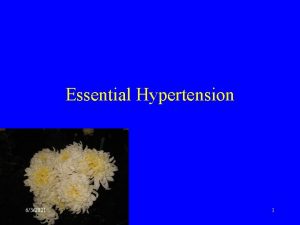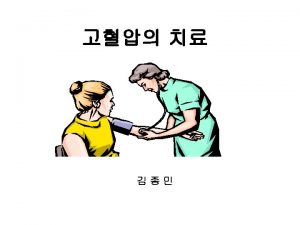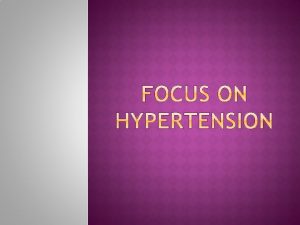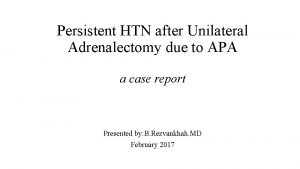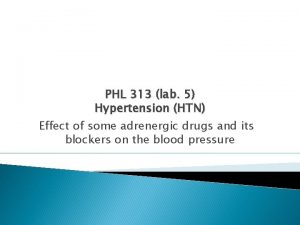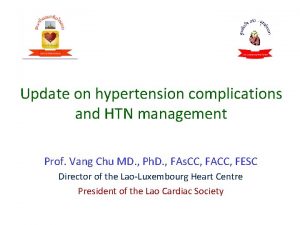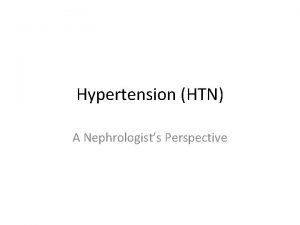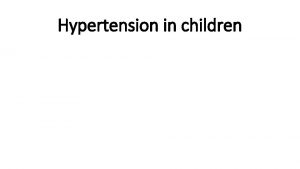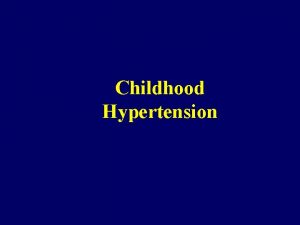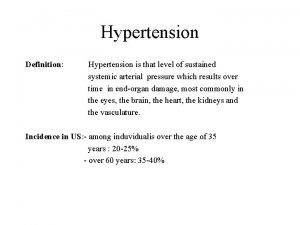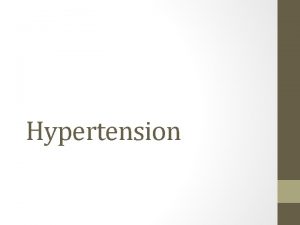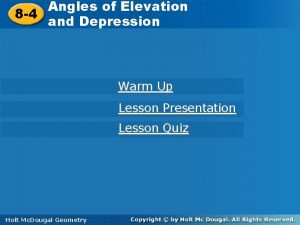HYPERTENSION Definition HTN is a persistent elevation of























- Slides: 23

HYPERTENSION

Definition • HTN is a persistent elevation of the SBP above 140 mm. Hg and DBP above 90 mm. Hg. • Over sustained period of time • Based on 2 or more reading at different intervals

Patho • *multifactoral condition • Sign – used to monitor clinical status • Risk factor- involves atherosclerotic plaques within arterial walls • Disease- major contributor to death from cadiac, renal, and peripheral vascular disease

Types • Primary (essential) – elevated BP of unknown cause; can not identify • Secondary – elevated BP of known cause. Ex: renal Dz, DM, dyslipidemia

Factors that affect BP • *Age • *Exercise • *Stress • • *Race •

Factors that affect BP • *Age *Gender • *Exercise *Medication • *Stress *Obesity • *Race *Diurnal variation • *Disease process

Risk Factors • Risk • positive risk factors • Obesity • Stress • Cigarette smoking • Hypercholestere mia • Increased Na

Risk Factors • Risk • positive risk factors • Obesity • Stress • Cigarette smoking • Hypercholestere mia • Increased Na • • At risk for Heart attack Heart failure Stroke Cardiac Dz Renal failure Impaired vision

Signs & Symptoms • Subjective • • H/A (occipital) Lightheadedness Tinnitis Easy fatigue Visual disturbances Palpitations Brief lapses in memory

Signs & Symptoms • Subjective • • Objective H/A (occipital) • Elevated BP Lightheadedness readings Tinnitis • Retinal chenges Easy fatigue • Possible Visual disturbances hematuria Palpitations • Epistaxis Brief lapses in • Cardiac memory hypertrophy

Classification Type SBP DBP Follow-up Normal <120 <80 1 -2 yr Pre-HTN 120 -139 805 -89 1 yr Stage 1 (mild) 140 -159 90 -99 1 months Stage 2 (Moderate) >100 1 week >160

Assessment • *Obtain complete history (check for organ damage) • Pain- angina, intermittent claudation, occipital H/A, •

Assessment • Polyuria, nocturia, fatigue, dizziness, epistaxis, dyspnea on exertion • *Alteration in speech, vision or balance • Labs- U/A, Blood chemistry, EKG • cholesterol level

Nsg Dx • Knowledge Deficit • Disease process • Exercise *Medication • Noncompliance • Treatment regimen • Exercise * Diet *Diet

Plan/Goal • Client will: understand the disease process & its treatment. • Participate in self- care programs • Absence of complications

Medical Management • * Diet & Wt. reduction – (restrict Na, Kcal, cholesterol) • *Lifestyle changes – alcohol moderation, exercise regimen, cessation of smoking • *Antihypertensive drug therapy

Nurse’s Role • Patient/Family teaching • *med, usage, S/E, no abrupt stopping, when to take (no hot baths, alcohol, or strenuous exercise within 3 hrs of taking meds)

Nurse’s Role Cont’ • Early detection & screening • *self-monitoring @ home or drug store • Risk modification programs • *develop gradual exercise program

Nurse’s Role Cont’ • Refer for medical treatment • Encourage/Facilitate client in complying with treatment regimen • • Administer meds as ordered Monitor I/O Daily Wt. Inform of importance of follow-up care

Evaluation • *Maintain adequate tissue perfusion • *Complies with self-care program • *Has no complications

HTN Crises • HTN emergency (crisis)- acute, lifethreatening BP elevations • >180/120 mm Hg • *BP must be lowered immediately • *halt/prevent damage to target organs • *requires ICU monitoring with IV meds • HTN urgency- BP must be lowered within a few hours • * managed with oral meds • Both requires close monitoring of BP & cardiovascular status.

Orthostatic Hypotension • BP that is below normal • BP falls when pt. sits or stands • *Caused by peripheral vasodilation – (blood leaves the central organs and moves to the periphery). • Pt. c/o feeling faint

Nurse’s Role • Place in supine position for 2 -3 minutes • Check & record BP & pulse • Encourage to sit or stand slowly • Recheck BP & P after 1 minute • Compare results : rise>40 or drop<30, indicate abnormalities
 Persistent vs non persistent http
Persistent vs non persistent http Persistent elevation meaning
Persistent elevation meaning Htn emergency vs urgency
Htn emergency vs urgency Hypertensive urgency vs emergency
Hypertensive urgency vs emergency Htn urgency vs emergency
Htn urgency vs emergency Hubungan htn dengan ilmu lainnya
Hubungan htn dengan ilmu lainnya Htn vs goap
Htn vs goap Malignant hypertension
Malignant hypertension Htn statis dan dinamis
Htn statis dan dinamis Cad htn
Cad htn Bp = co x svr
Bp = co x svr Definition of hypertension
Definition of hypertension Definition of pulmonary hypertension
Definition of pulmonary hypertension Definition of hypertension
Definition of hypertension Pulmonary hypertension definition
Pulmonary hypertension definition Portal hypertension definition
Portal hypertension definition Angle of elevation and depression definition
Angle of elevation and depression definition Elevation definition ap human geography
Elevation definition ap human geography Boiling point elevation equation
Boiling point elevation equation Hypertension artérielle
Hypertension artérielle Vital signs cpr
Vital signs cpr Hypertension
Hypertension Disease state awareness
Disease state awareness Oedeme papillaire stade
Oedeme papillaire stade
